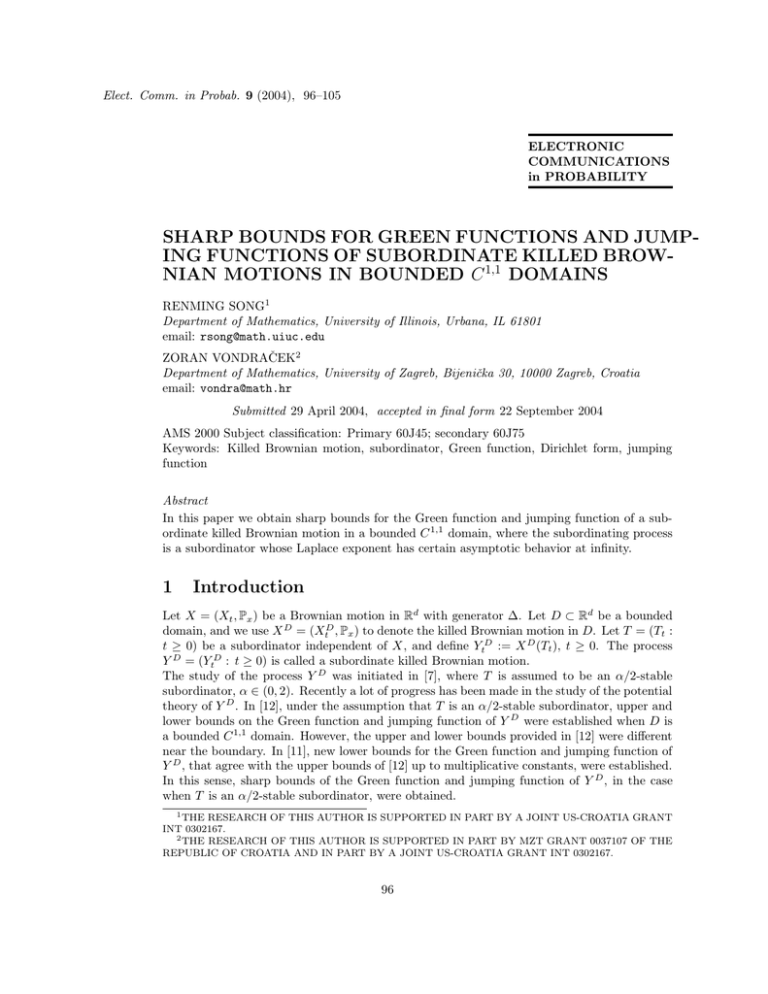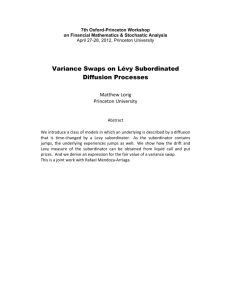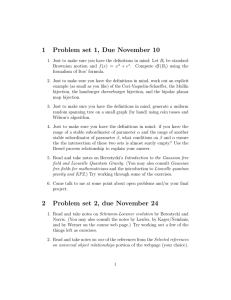SHARP BOUNDS FOR GREEN FUNCTIONS AND JUMP- NIAN MOTIONS IN BOUNDED
advertisement

Elect. Comm. in Probab. 9 (2004), 96–105
ELECTRONIC
COMMUNICATIONS
in PROBABILITY
SHARP BOUNDS FOR GREEN FUNCTIONS AND JUMPING FUNCTIONS OF SUBORDINATE KILLED BROWNIAN MOTIONS IN BOUNDED C 1,1 DOMAINS
RENMING SONG1
Department of Mathematics, University of Illinois, Urbana, IL 61801
email: rsong@math.uiuc.edu
ZORAN VONDRAČEK2
Department of Mathematics, University of Zagreb, Bijenička 30, 10000 Zagreb, Croatia
email: vondra@math.hr
Submitted 29 April 2004, accepted in final form 22 September 2004
AMS 2000 Subject classification: Primary 60J45; secondary 60J75
Keywords: Killed Brownian motion, subordinator, Green function, Dirichlet form, jumping
function
Abstract
In this paper we obtain sharp bounds for the Green function and jumping function of a subordinate killed Brownian motion in a bounded C 1,1 domain, where the subordinating process
is a subordinator whose Laplace exponent has certain asymptotic behavior at infinity.
1
Introduction
Let X = (Xt , Px ) be a Brownian motion in Rd with generator ∆. Let D ⊂ Rd be a bounded
domain, and we use X D = (XtD , Px ) to denote the killed Brownian motion in D. Let T = (Tt :
t ≥ 0) be a subordinator independent of X, and define YtD := X D (Tt ), t ≥ 0. The process
Y D = (YtD : t ≥ 0) is called a subordinate killed Brownian motion.
The study of the process Y D was initiated in [7], where T is assumed to be an α/2-stable
subordinator, α ∈ (0, 2). Recently a lot of progress has been made in the study of the potential
theory of Y D . In [12], under the assumption that T is an α/2-stable subordinator, upper and
lower bounds on the Green function and jumping function of Y D were established when D is
a bounded C 1,1 domain. However, the upper and lower bounds provided in [12] were different
near the boundary. In [11], new lower bounds for the Green function and jumping function of
Y D , that agree with the upper bounds of [12] up to multiplicative constants, were established.
In this sense, sharp bounds of the Green function and jumping function of Y D , in the case
when T is an α/2-stable subordinator, were obtained.
1 THE RESEARCH OF THIS AUTHOR IS SUPPORTED IN PART BY A JOINT US-CROATIA GRANT
INT 0302167.
2 THE RESEARCH OF THIS AUTHOR IS SUPPORTED IN PART BY MZT GRANT 0037107 OF THE
REPUBLIC OF CROATIA AND IN PART BY A JOINT US-CROATIA GRANT INT 0302167.
96
Sharp bounds for Green and jumping functions of subordinate killed Brownian motions
97
The purpose of this paper is to obtain sharp bounds for the Green function and jumping
function of Y D for a much larger class of subordinating processes T . The sharp bounds
obtained in this paper are very useful. For instance, they can be used to give concrete criteria
for functions or measures to belong to the classes S1 (X) and A∞ (X), defined in [2], [3] and
[4], when the process X is the subordinate killed Brownian motion dealt with in this paper.
The content of this paper is organized as follows. In Section 2 we recall some basic facts about
special subordinators and subordinate killed Brownian motion and in Section 3 we establish
our main results.
In this paper we write f ∼ g as x → ∞ (respectively, x → 0), if limx→∞ f (x)/g(x) = 1
(respectively, limx→0 f (x)/g(x) = 1).
2
Preliminaries
Let T = (Tt : t ≥ 0) be a subordinator, that is, an increasing Lévy process taking values in
[0, ∞] with T0 = 0. The Laplace exponent of the subordinator T is a function φ : (0, ∞) →
[0, ∞) such that
E[exp(−λTt )] = exp(−tφ(λ)) , λ > 0.
(2.1)
The function φ has a representation
φ(λ) = a + bλ +
Z
∞
(1 − e−λt ) µ(dt) .
(2.2)
0
Here a, b ≥ 0, and µ is a σ-finite measure on (0, ∞) satisfying
Z ∞
(t ∧ 1) µ(dt) < ∞ .
0
The constant a is called the killing rate, b the drift, and µ the Lévy measure of the subordinator
T.
Recall that a C ∞ function φ : (0, ∞) → [0, ∞) is called a Bernstein function if (−1)n Dn φ ≤ 0
for every n ∈ N. It is well known that a function φ : (0, ∞) → R is a Bernstein function if and
only if it has the representation given by (2.2).
The potential measure of the subordinator T is defined by
Z ∞
U (A) = E
1(Tt ∈A) dt ,
(2.3)
0
and its Laplace transform is given by
Z ∞
Z
LU (λ) =
e−λt dU (t) = E
0
∞
exp(−λTt ) dt =
0
1
.
φ(λ)
(2.4)
It is well known that if the drift b is strictly positive, then the potential measure U is absolutely
continuous with a density u : (0, ∞) → R that is continuous and positive, and u(0+) = 1/b
(e.g., [1], p.79). Moreover, for every t > 0, u(t) ≤ u(0+) (e.g., [10]). In order to establish
the main results of this paper we will need the existence of a decreasing potential density for
subordinators not necessarily having a strictly positive drift. A large class of such subordinators, called special subordinators, was introduced and studied in [13]. We recall the definition
below.
98
Electronic Communications in Probability
Definition 2.1 A Bernstein function φ is called a special Bernstein function if the function
λ/φ(λ) is also a Bernstein function. A subordinator T is called a special subordinator if its
Laplace exponent φ is a special Bernstein function.
The family of special Bernstein functions is very large, and it contains in particular the family
of complete Bernstein functions. Recall that a function φ : (0, ∞) → R is called a complete
Bernstein function if there exists a Bernstein function η such that
φ(λ) = λ2 Lη(λ),
λ > 0.
The family of complete Bernstein functions is also very large and it contains the following well
known Bernstein functions: (i) λα , α ∈ (0, 1]; (ii) (λ + 1)α − 1, λ ∈ (0, 1), and (iii) ln(1 + λ). It
is known (see [8], for instance) that every complete Bernstein function is a special Bernstein
function and that a Bernstein function φ of the form (2.2) is a complete Bernstein function if
and only if its integral part
Z ∞
φ1 (λ) =
(1 − e−λt )µ(dt), λ > 0
(2.5)
0
is a complete Bernstein function.
One of the main results about special subordinators proved in [13] is the following: If T is a
special subordinator such that b > 0 or µ((0, ∞)) = ∞, then the potential measure U of T
has a decreasing density u. For other results about special subordinators, as well as for many
examples, we refer the reader to [13].
Suppose that X = (Xt : t ≥ 0) is a Brownian motion in Rd with generator ∆. Suppose that
D is a bounded domain in Rd and that X D is the killed Brownian motion in D. Suppose that
T = (Tt : t ≥ 0) is a subordinator independent of X. The process Y D = (YtD : t ≥ 0) defined
by YtD = X D (Tt ) is called a subordinate killed Brownian motion.
Let pD (t, x, y), t ≥ 0, x, y ∈ D, denote the transition density of X D and (PtD : t ≥ 0) the
transition semigroup of X D . It is well known that the potential operator of the subordinate
process Y D has a density U D given by the formula
Z ∞
D
pD (t, x, y) U (dt) .
(2.6)
U (x, y) =
0
We call U D (x, y) the Green function of Y D . In case the potential measure U of the subordinator
T has a density u, we may write
Z ∞
pD (t, x, y)u(t) dt .
(2.7)
U D (x, y) =
0
Let (E, F) be the Dirichlet form corresponding to Y D , then H 1 (D) ⊂ F. When the drift b of
T is positive, we have F = H 1 (D) and for u ∈ F,
Z
Z
Z
u2 (x)κD (x)dx,
(u(x) − u(y))2 J D (x, y)dxdy +
|∇u|2 (x)dx +
E(u, u) = b
D
D
D×D
where
J D (x, y) =
1
2
Z
∞
pD (s, x, y)µ(ds),
0
Sharp bounds for Green and jumping functions of subordinate killed Brownian motions
and
κD (x) = a +
When T has no drift,
Z
F = {u ∈ L2 (D) :
99
∞
(1 − PsD 1D (x))µ(ds).
0
Z
∞
(u − PsD u, u)µ(ds) < ∞}
0
(2.8)
and for any u ∈ F,
E(u, u) =
Z
2
D
(u(x) − u(y)) J (x, y)dxdy +
D×D
Z
u2 (x)κD (x)dx,
D
with J D and κD given above. The functions J D and κD are called the jumping function and
killing functions of Y D respectively. For the above facts on the Dirichlet form of Y D , please
see [9].
We recall now the definition of a C 1,1 domain. A bounded domain D ⊂ Rd , d ≥ 2, is called a
bounded C 1,1 domain if there exist positive constants r0 and M with the following property:
for every z ∈ ∂D and every r ∈ (0, r0 ], there exist a function Γz : Rd−1 → R satisfying the
condition |∇Γz (ξ) − ∇Γz (η)| ≤ M |ξ − η| for all ξ, η ∈ Rd−1 , and an orthonormal coordinate
system CSz such that if y = (y1 , . . . , yd ) in CSz coordinates, then
B(z, r) ∩ D = B(z, r) ∩ {y : yd > Γz (y1 , . . . , yd−1 } .
When we speak of a bounded C 1,1 domain in R we mean a finite open interval.
3
Main results
In this section we will always assume that D is a bounded C 1,1 domain in Rd . For any x ∈ D,
we use ρ(x) to denote the distance between x and ∂D.
In this section we will establish sharp estimates on the Green function and jumping function
of Y D following the method of [11]. Our basic information is the Laplace exponent φ of
the subordinator T and our basic assumption will be the asymptotic behavior of the Laplace
exponent φ(λ) at infinity. We assume that φ has the representation (2.2).
For the Green function estimates, we will consider two cases: In the first case we will consider
special subordinators T with Laplace exponent φ satisfying φ(λ) ∼ γ −1 λα/2 as λ → ∞ for
α ∈ (0, 2) and a positive constant γ. Note that in this case the drift of the subordinator must
be zero. In the second case, the drift b is strictly positive, but we do not assume that the
subordinator T is special. Note that the drift b is strictly positive if and only if φ(λ) ∼ bλ as
λ → ∞. We put these two cases into the following assumption:
Assumption A: The Laplace exponent φ of T satisfies
φ(λ) ∼ γ −1 λα/2 ,
λ → ∞,
(3.1)
for some α ∈ (0, 2], and in the case α ∈ (0, 2) we always assume that φ is a special Bernstein
function.
Note that in the case α = 2, we have that γ −1 = b, the drift of the subordinator.
Assumption A implies that, in the case α ∈ (0, 2), the Lévy measure µ of T must satisfy
µ((0, ∞)) = ∞. So under the Assumption A, the subordinator T has a potential density u(t).
100
Electronic Communications in Probability
In the case α ∈ (0, 2), it follows from (2.4) and Assumption A by use of the Tauberian theorem
and the monotone density theorem, that
u(t) ∼
γ
tα/2−1 ,
Γ(α/2)
t→0+ .
Therefore, for each A > 0, there exists a positive constant c1 = c1 (A) such that
u(t)
≥ c1 ,
tα/2−1
0 < t ≤ A.
Moreover, there exists a positive constant c2 such that
½
u(t)
c2 ,
t<1
≤
−α/2+1
α/2−1
c
t
,
t≥1
t
2
(3.2)
(3.3)
Note also that both (3.2) and (3.3) are valid for the case of a strictly positive drift (i.e., α = 2).
For the jumping kernel estimates we will need the following assumption.
Assumption B: The Laplace exponent φ of T is a complete Bernstein function and satisfies
one of the following two conditions: (i) The drift b is positive and the integral part φ 1 of φ has
the following asymptotic behavior
φ1 (λ) ∼ γ −1 λβ/2 ,
λ → ∞,
(3.4)
for some β ∈ (0, 2). (ii) b = 0 and φ has the following asymptotic behavior
φ(λ) ∼ γ −1 λβ/2 ,
λ → ∞,
(3.5)
for some β ∈ (0, 2).
It is known (see [8] for instance) that the Lévy measure of any complete Bernstein function
has a completely monotone density. The asymptotic relations (3.4) and (3.5) imply that the
Lévy measure µ of T must satisfy µ((0, ∞)) = ∞. Corollary 2.4 of [13] implies that the
Lévy measure ν of the complete Bernstein function λ/φ1 (λ) in case (i), and of the complete
Bernstein function λ/φ(λ) in case (ii), satisfies ν((0, ∞)) = ∞. Hence the potential measure
of the subordinator with Laplace exponent λ/φ1 (λ) in case (i), and with Laplace exponent
λ/φ(λ) in case (ii), has a decreasing density v. Again from Corollary 2.4 of [13] we know that
the Lévy measure µ of φ and the potential density v are related as follows
v(t) = ã + µ((t, ∞)) ,
t > 0,
with ã = 0 in case (i) and ã = a in case (ii). It follows from (3.4), (3.5), the Tauberian theorem
and the monotone density theorem that
v(t) ∼
1
t−β/2 ,
γΓ(1 − β/2)
hence we have
µ((t, ∞)) ∼
1
t−β/2 ,
γΓ(1 − β/2)
t → 0+ ,
t→0+ .
Using the monotone density theorem again we get that
µ(t) ∼
β
t−β/2−1 ,
2γΓ(1 − β/2)
t → 0+ ,
(3.6)
Sharp bounds for Green and jumping functions of subordinate killed Brownian motions
101
where µ(t) denotes the density of the measure µ. Therefore, for each A > 0, there exists a
positive constant c3 = c3 (A) such that
µ(t)
≥ c3 , 0 < t ≤ A .
t−β/2−1
Moreover, there exists a positive constant c4 such that
½
µ(t)
c4 ,
t<1
≤
c4 tβ/2+1 , t ≥ 1
t−β/2−1
(3.7)
(3.8)
The sharp estimates on the Green function of Y D are included in the following result.
Theorem 3.1 Suppose that D is a bounded C 1,1 domain in Rd and that the subordinator
T = (Tt : t ≥ 0) satisfies Assumption A. If d > α, then there exist positive constants C1 ≤ C2
such that for all x, y ∈ D
µ
¶
¶
µ
ρ(x)ρ(y)
1
1
ρ(x)ρ(y)
D
∧1
≤ U (x, y) ≤ C2
∧1
.
C1
|x − y|2
|x − y|d−α
|x − y|2
|x − y|d−α
Proof. Upper bound. It is known (see [5] and [12]) that there exists a positive constant c 5
such that for all t > 0 and any x, y ∈ D,
µ
¶
|x − y|2
pD (t, x, y) ≤ c5 t−d/2−1 ρ(x)ρ(y) exp −
.
(3.9)
6t
Hence by the formula for U D ,
U D (x, y)
Z
∞
2
t−d/2−1 e−|x−y| /6t u(t) dt
0
µ
¶
Z ∞
|x − y|2
sd/2−1 e−s u
= c6 ρ(x)ρ(y)|x − y|−d
ds
6s
0
Z ∞
u(|x − y|2 /6s)
= c7 ρ(x)ρ(y)|x − y|−d−2+α
ds .
sd/2−α/2 e−s
(|x − y|2 /6s)α/2−1
0
≤
c5 ρ(x)ρ(y)
For α = 2, the last integral is clearly bounded by a positive constant. For 0 < α < 2, we
estimate the integral by use of (3.3):
Z |x−y|2 /6 Z ∞
Z ∞
u(|x − y|2 /6s)
+
ds
=
sd/2−α/2 e−s
(|x − y|2 /6s)α/2−1
|x−y|2 /6
0
0
Z |x−y|2 /6
Z ∞
≤ c2
sd/2−α/2 e−s (|x − y|2 /6s)−α/2+1 ds + c2
sd/2−α/2 e−s ds
|x−y|2 /6
0
≤
≤
c8
c9
Ã
|x − y|
µZ
∞
−α+2
Z
2
|x−y| /6
s
e
0
sd/2−1 e−s ds +
0
d/2−1 −s
Z
∞
ds +
Z
∞
s
|x−y|2 /6
sd/2−α/2 e−s ds
0
d/2−α/2 −s
¶
e
ds
!
= c10 .
Here we used that |x − y| ≤ diam (D). Hence we have shown that there exists a positive
constant c11 such that for all x, y ∈ D,
U D (x, y) ≤ c11
ρ(x)ρ(y)
.
|x − y|d+2−α
(3.10)
102
Electronic Communications in Probability
Let p(t, x, y), t ≥ 0, x, y ∈ Rd , be the transition density of the Brownian motion X in Rd .
Then pD (t, x, y) ≤ p(t, x, y), implying
D
U (x, y) ≤
Z
∞
p(t, x, y)u(t) dt .
0
A similar (but easier) argument to the one in the paragraph above shows that there is a
constant c12 > 0 such that
Z
∞
p(t, x, y)u(t) dt ≤ c12 |x − y|α−d ,
x, y ∈ D.
0
Therefore,
U D (x, y) ≤ c12 |x − y|α−d ,
x, y ∈ D.
(3.11)
Combining (3.10) and (3.11) we get the upper bound of the theorem.
Lower bound. It was proved in [14] and [11] that for any A > 0, there exist positive constants
c13 and c14 such that for any t ∈ (0, A] and any x, y ∈ D,
pD (t, x, y) ≥ c13
µ
ρ(x)ρ(y)
∧1
t
¶
µ
¶
c14 |x − y|2
t−d/2 exp −
.
t
(3.12)
Hence by the formula for U D ,
D
U (x, y) ≥ c13
Z
A
0
µ
¶
ρ(x)ρ(y)
∧ 1 t−d/2 exp{−c14 |x − y|2 /t}u(t) dt .
t
Assume x 6= y. Let R be the diameter of D and assume that A has been chosen so that A = R 2 .
Then for any x, y ∈ D, ρ(x)ρ(y) < R2 = A. The lower bound is proved by considering two
separate cases:
|x − y|2
2R2
(i)
<
. In this case we have:
ρ(x)ρ(y)
A
D
U (x, y)
ρ(x)ρ(y)
µ
¶
ρ(x)ρ(y)
≥ c13
∧ 1 t−d/2 exp{−c14 |x − y|2 /t}u(t) dt
t
0
Z ∞
−d+2
≥ c15 |x − y|
sd/2−2 e−s u(c14 |x − y|2 /s) ds
2
Z
c14 |x−y|
ρ(x)ρ(y)
∞
≥
c15 |x − y|−d+2
Z
=
c16 |x − y|−d+α
Z
2c14 R2
A
sd/2−2 e−s u(c14 |x − y|2 /s) ds
∞
2c14 R2
A
sd/2−α/2−1 e−s
u(c14 |x − y|2 /s)
ds .
(c14 |x − y|2 /s)α/2−1
For s > 2c14 R2 /A, we have that c14 |x − y|2 /s ≤ A/2, hence we can estimate the fraction in
the above integral by c1 , see (3.2). Hence,
U D (x, y) ≥ c17 |x − y|−d+α .
Sharp bounds for Green and jumping functions of subordinate killed Brownian motions
(ii)
103
2R2
|x − y|2
≥
. In this case we have:
ρ(x)ρ(y)
A
D
U (x, y)
≥
=
=
≥
c13 ρ(x)ρ(y)
Z
A
t−d/2−1 exp{−c14 |x − y|2 /t}u(t) dt
ρ(x)ρ(y)
c18 ρ(x)ρ(y)|x − y|−d
c19 ρ(x)ρ(y)|x − y|
Z
c14 |x−y|2
ρ(x)ρ(y)
c14 |x−y|2
A
−d+α−2
c19 ρ(x)ρ(y)|x − y|−d+α−2
Z
Z
sd/2−1 e−s u(c14 |x − y|2 /s) ds
c14 |x−y|2
ρ(x)ρ(y)
c14
|x−y|2
s−d/2−α/2 e−s
A
2c14 R2
A
R2
c14
A
s−d/2−α/2 e−s
u(c14 |x − y|2 /s)
ds
(c14 |x − y|2 /s)α/2−1
u(c14 |x − y|2 /s)
ds .
(c14 |x − y|2 /s)α/2−1
Again, if s > c14 R2 /A ≥ c14 |x − y|2 /A, then c14 |x − y|2 /A < s, and we use (3.2) to estimate
the fraction above by c1 . Hence,
U D (x, y) ≥ c20
ρ(x)ρ(y)
.
|x − y|d−α+2
Combining the two cases above we arrive at the lower bound of the theorem.
¤
Remark 3.2 Note that the theorem above implies that when b is positive, the Green function
U D of Y D is comparable to the Green function of X D .
The sharp estimates on the jumping function of Y D are included in the following result.
Theorem 3.3 Suppose that D is a bounded C 1,1 domain in Rd and that the subordinator
T = (Tt : t ≥ 0) satisfies Assumption B. Then there exist positive constants C3 ≤ C4 such
that for all x, y ∈ D
µ
¶
¶
µ
ρ(x)ρ(y)
1
1
ρ(x)ρ(y)
D
∧1
≤ J (x, y) ≤ C4
∧1
.
C3
|x − y|2
|x − y|d+β
|x − y|2
|x − y|d+β
Proof. The proof of this theorem is the same as that of Theorem 3.1, the only differences are
that we use Assumption B, the formula for J, (3.7) and (3.8) instead of Assumption A, the
formula for U D , (3.2) and (3.3). We omit the details.
¤
Using arguments similar to that of Proposition 3.2 of [12], we can get the following estimates
on the killing function of Y D .
Theorem 3.4 Suppose that D is a bounded C 1,1 domain in Rd and that the subordinator
T = (Tt : t ≥ 0) satisfies Assumption B. Then there exist positive constants C5 ≤ C6 such
that
C5 (ρ(x))−β ≤ κD (x) ≤ C6 (ρ(x))−β , x ∈ D.
104
Electronic Communications in Probability
Proof. Let Z = (Zt : t ≥ 0) be the subordinate Brownian motion defined by Zt = X(Tt ).
Clearly, the killing function κ(x) of Z is given by κ(x) = a. It follows from [9] that the jumping
function J(x, y) of this process is given by
Z
1 ∞
p(t, x, y)µ(t)dt,
(3.13)
J(x, y) =
2 0
where p(t, x, y) is the transition density of X. Let Z D = (ZtD , Px ) be the process Z killed
upon exiting D. Then it is known (see [6], for instance) that the killing function κ̃ D (x) of Z D
is given by
Z
κ̃D (x) = a + 2
J(x, y)dy,
x ∈ D.
Dc
Now using (3.6), (3.13) and an argument similar to that of Theorem 3.1 of [10] we get that
J(x, y) ∼ c21 |x − y|−d−β ,
|x − y| → 0
for some constant c21 > 0. From this we immediately get that there exist constants 0 < c22 <
c23 such that
c22 (ρ(x))−β ≤ κ̃D (x) ≤ c23 (ρ(x))−β , x ∈ D.
Repeating the argument of Proposition 3.2 of [12] we get that there exist constants 0 < c 24 <
c25 such that
c24 κ̃D (x) ≤ κD (x) ≤ c25 κ̃D (x), x ∈ D.
The proof is now finished.
¤
References
[1] J. Bertoin. Lévy Processes. Cambridge University Press, Cambridge, 1996.
[2] Z.-Q. Chen. Gaugeability and conditional gaugeability. Trans. Amer. Math. Soc. 354 (2002),
4639–4679
[3] Z.-Q. Chen and R. Song. General gauge and conditional gauge theorems. Ann. Probab. 30 (2002),
1313–1339.
[4] Z.-Q. Chen and R. Song. Conditional gauge theorem for non-local Feynman-Kac transforms.
Probab. Theory Rel. Fields 125 (2003), 45–72.
[5] E. B. Davies. Heat kernels and spectral theory. Cambridge University Press, Cambridge, 1989.
[6] M. Fukushima, Y. Oshima and M. Takeda. Dirichlet forms and symmetric Markov processes.
Walter De Gruyter, Berlin, 1994.
[7] J. Glover, M. Rao, H. Šikić and R. Song. Γ-potentials. in Classical and modern potential theory
and applications (Chateau de Bonas, 1993). 217–232, Kluwer Acad. Publ., Dordrecht, 1994.
[8] N. Jacob. Pseudo Differential Operators and Markov Processes. Vol. 1, Imperial College Press,
London, 2001.
[9] K. Okura. Recurrence and transience criteria for subordinated symmetric Markov processes.
Forum Math. 14 (2002), 121–146.
Sharp bounds for Green and jumping functions of subordinate killed Brownian motions
[10] M. Rao, R. Song and Z. Vondraček. Green function estimates and Harnack inequality for subordinate Brownian motions. Preprint, 2004.
[11] R. Song. Sharp bounds on the density, Green function and jumping function of subordinate killed
BM. Probab. Theory Rel. Fields 128 (2004), 606-628.
[12] R. Song and Z. Vondraček. Potential theory of subordinate killed Brownian motion in a domain.
Probab. Theory Rel. Fields 125 (2003), 578–592.
[13] R. Song and Z. Vondraček. Potential theory of special subordinators and subordinate killed stable
processes. Preprint, 2004
[14] Q. S. Zhang. The boundary behavior of heat kernels of Dirichlet Laplacians. J. Differential
Equations 182 (2002), 416–430.
105






